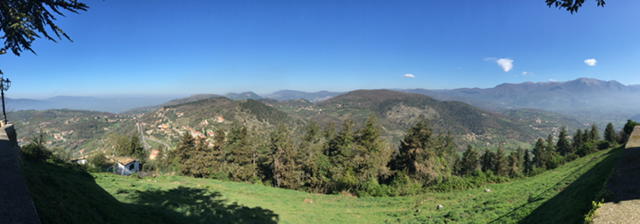
Dear Blog Readers –
I just spent the week taking a journalism course in the small town of Fiuggi, in the hills a little south of Rome. I loved going back to “school” and spending hours in the classroom learning about Italian law, the modern history of Europe, and economics. While I was there, I discovered that in the nearby town of Fumone there is the Castle where Celestine V, the Pope who resigned in 1294, was imprisoned and eventually died. Having covered the resignation of Pope Benedict XVI in February 2013 (see blog post: The Pope Resigns!) I was curious to visit the castle and see his cell.
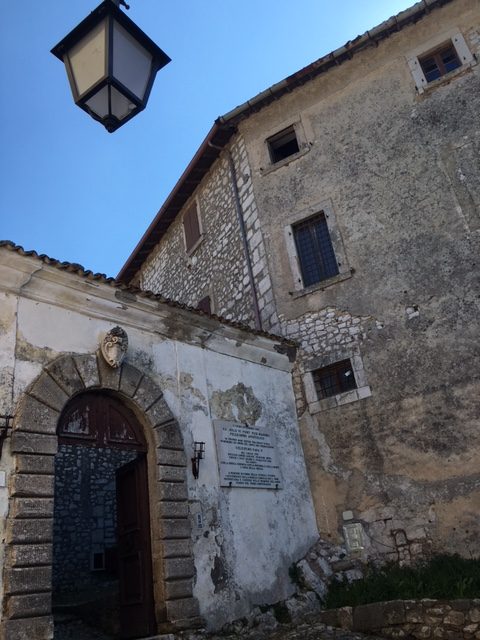
Pope Celestine V was born Pietro Angelerio to humble farmers in southern Italy. He lived most of his life as a monk and hermit, founding the Celestines, a monastic order. In an extraordinary set of circumstances, he was elected Pope against his will in 1294 following a conclave that was at a two year impasse as the noble Orsini and Colonna families battled it out for the papacy. He is one of the few non-cardinals to ever be elected Pope.
The humble hermit had little desire for throwing himself into the unscrupulous world of the Vatican, and his life as a monk in the Apennine mountains left him woefully unprepared. Unlike the cardinals, he was not used to wealth and power. He rode a donkey to his coronation. He didn’t even speak Latin, the official working language of the Vatican. Just five months into his papacy, Pope Celestine V resigned and tried to slip quietly away to dedicate himself to a life of prayer.
He was not lucky. He was widely derided by the public, including Dante who placed poor Celestine V in his “Inferno” putting him among the cowards at the gates of hell describing him like this:
“I looked, and I beheld the shade of him Who made through cowardice the great refusal. “
Celestine V’s successor, Pope Boniface VIII, fearing an anti-pope, sent off soldiers to capture the fleeing pontiff and had him brought to the castle in Fumone, a prison that was part of the Papal States.
There the poor Celestine V lived in the prison-castle in a miserably small cell sleeping on a hay-covered stone shelf that alternated as bed and altar.
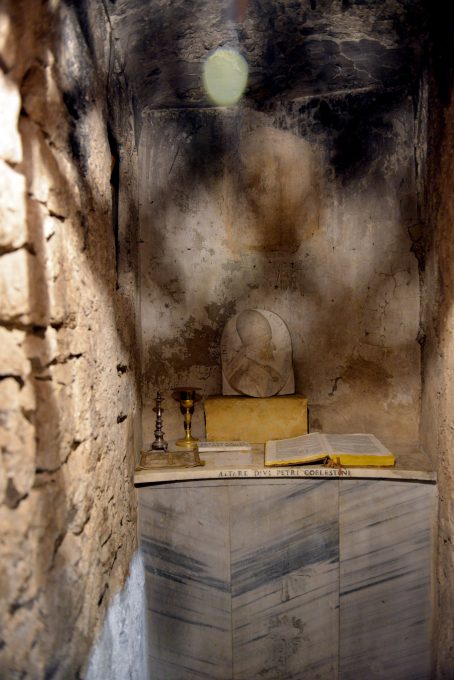
As a guide took me through the Fumone Castle, I was shocked when we arrived at Celestine’s cell. It had long, metal bars over the doorway, and the space inside was tiny. The bed/altar would have been too short for me to stretch out on. It was a sunny, warm day outside but inside the cell was cold and damp.
Two years after his resignation, Pope Celestine V died in his cell in the Fumone Castle. He was 87. The guide informed me that since his death, they have discovered he had a hole in his skull and some believe that Pope Boniface VIII ordered him killed with a nail hammered into his head. There is plenty of comment about this on the Internet, but I have no idea if there is any truth to it.
In 2009 Pope Benedict XVI, during a visit to the earthquake-devastated town of L’Aquila, stopped and prayed by the remains of Pope Celestine V in the Basilica of Santa Maria di Collemaggio. In what later became considered a presage of what was to come, Benedict XVI placed his pallium –the woolen vestment worn around his neck as a symbol of the power bestowed on him—on the case with Celestine’s body.
Benedict resigned on February 28, 2013.
In case anyone is be worried that Benedict XVI might be getting a similar treatment, they need not fret. My friend Mary Shovlain, the Vatican Correspondent for EWTN Nightly News, recently visited the Pope Emeritus. She has kindly allowed me to use this picture of Benedict XVI sitting with his longtime secretary Archbishop Georg Gaenswein in the Vatican Gardens. She said they pray the rosary together there every afternoon. Mary said she found Benedict to be “joyful.”
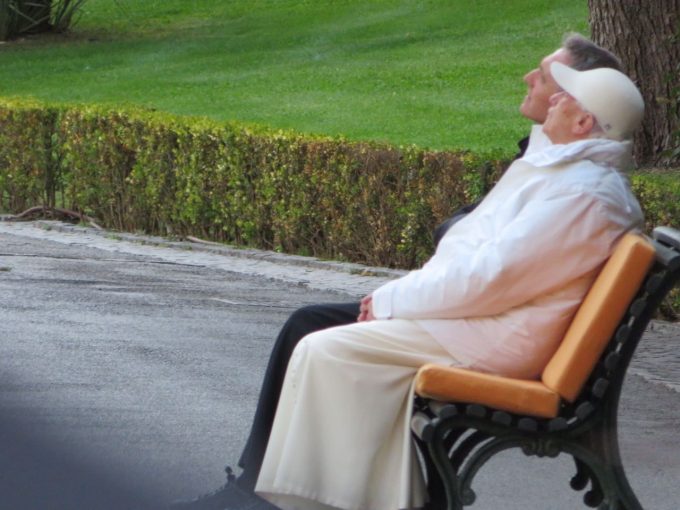
On Saturday, speaking at a vigil service at the Saint Mary Major Basilica in Rome ahead of World Youth Day in Panama 2019, Pope Francis, now 80, made the crowd a little nervous when he said, “At my age, we are about to pass away,” and later noted, “I don’t know if it will be me, but the Pope will be in Panama!”
Since shortly after his election, Pope Francis has said he expected his papacy would be brief and has not ruled out resigning. Good grief, I hope he doesn’t do that. The last thing we need is for Vatican City to be turned into the Papal Pension Home for the elderly.
But back to the Castle of Fumone……there was much more to see than Celestine’s cell. It was honestly the creepiest castle I have ever seen in Italy. There was a mummified child in a display case and damsels down a well. Not to mention instruments of torture used at the castle.
Just past the small hallway with the cell of Celestine V was a small room containing a wooden case with the number 17 on top. Italians are extremely superstitious and 17 means bad luck.
The guide proceeded with a tale that seemed straight our of Grimm’s Fairy Tales (more Grim, than Grimm). Around 1600 a noble family by the name of Longhi bought the castle. The handsome Marquis and his beautiful wife had seven daughters but were desperate for a son. Finally they had a little boy, Federico Longhi. The mother was overjoyed with the birth and doted on her darling child. But with the birth of a son, the seven sisters were suddenly out of luck on the inheritance. Little Federico would get everything and they would be left empty-handed. So they came up with a strategy to do him in. Every day they put a little bit of arsenic in his food until he began having horrendous stomach pains and eventually died an agonizing death at age five.
The Marquise despaired over the death of her beloved boy and had him embalmed, his face covered in wax and then his body placed in a display case. At this point the guide pulled open the display case with the 17 on top, a light popped on and there was little Federico Longhi laid out in his clothes with all his toys around him. She explained that his body had become mummified. It was a bit macabre and I was eager to move on.
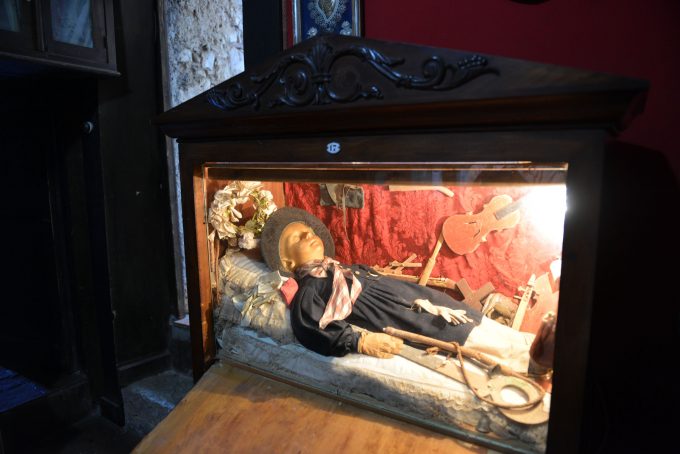
I asked the guide if little Federico’s ghost haunts the castle and she said no, but his mother’s does. Apparently the ghost of the Marquise traipses through the damp corridors at night wailing and moaning over the loss of her precious son.
We passed through a couple of doorways into the “Sala degli Antenati” (the room of the Ancestors) where I got to see the cast of characters from the “grim” tale in portraits lining the walls. There were the Marquis and Marquise at one end of the room, with the Marquise dressed in black, a mournful look on her face and a bust of little Federico at her side.

But more interesting than the sad parents were the beastly sisters. Here is one of the most repugnant of the lot.
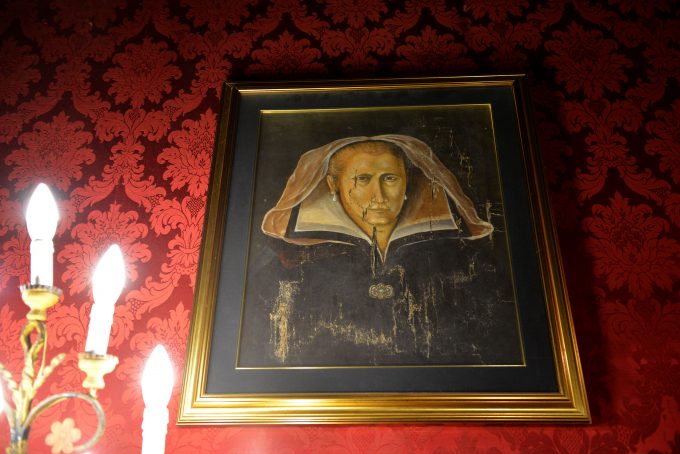
From there we passed up a narrow corridor and a staircase to the hanging garden. Along the staircase the guide pointed out various instruments. There was a gigantic vat used for baths in medieval times or for pouring boiling oil over the walls of the castle on attacking enemies. A piece of wood with dozens of long nails sticking out of it—a sort of torture seat, and a weird instrument with cogs, a handle for turning them, and a cord. I asked my guide about that and first she said it was for roasting meat, then she said it was also a clock and then concluded that it was also used for torturing prisoners. I think she was not prepared for my question. Here is the photo below and I will let you, dear blog readers tell me what you would do with this contraption.

And finally as if I had not had enough of murder, death, and torture my guide stopped by a little stone well that was in the front hallway. “This is the well of the virgins,” she declared. It was part of “jus primae noctis” a practice used in the medieval period. Since I, like poor Celestine V, never studied Latin, I had to get clarification on what this Latin expression means. Translated it means “Right of the First Night” or in French it is described more explicitly “Droit du Seigneur”, “Lord’s Right”. The tradition being that whenever a young girl was to get married, it was the feudal lord’s right to spend the wedding night with her. If he discovered she was not a virgin, she was promptly tossed down the well to her death. According to the guide they have found the bones of several women at the bottom. I would think their ghosts might be running around the castle wailing and moaning at night too!!
At that point I figured it was time I high-tailed it out of there before someone threw me down a well, fed me some arsenic or tried to run me through the roasting machine.
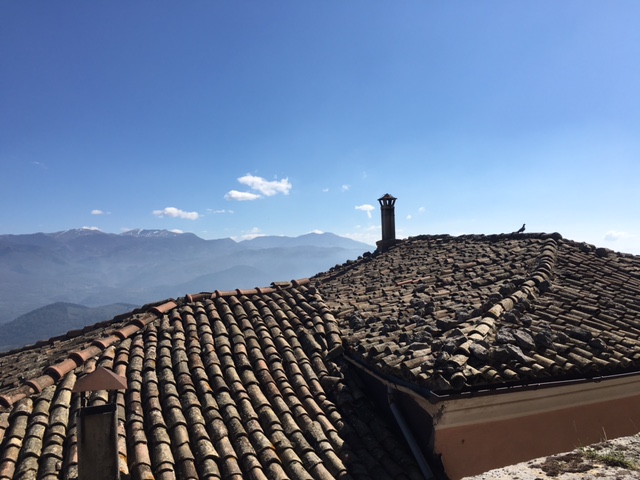

This is the creepiest castle ever – poor Pope Celestine, so unlucky and so badly treated, first by being made Pope and then by ending up in that dreadful castle! The best of castles always seem inhospitable to me, too large, too drafty, too elegant to ever be home. And I find myself recalling the reluctance of several Popes to become Pope. Francis, of course. And John 23, I’ve read, said yes with some reluctance, as a compromise candidate. Perhaps the best Popes are the reluctant ones. Benedict 16 revelled in it, then ran from it. He an Georg have a pretty cushy retirement, it seems, but I think are limited in what they can do and where they can go by the expectations of papal propriety. Hard to imagine him toes up on the beach in Rio, for instance, or back in Germany for a pub night of drinking and swapping stories with their old friends. Instead he has to say the rosary every day. Dreadfully dull. But way better than Celestine’s last years.
Thanks for sharing all this with us. Our snows have just melted, and we are at last getting a breath of spring. It may go up to 75 today, but it was chilly this morning. Happy Easter to all of you!
Happy Easter to you too! Ha! The thought of Ben and Georg on the beach in Rio o the pub in Munich — what a laugh. No, I think they are quite happy on their little bench in the Vatican Gardens reciting the rosary. Yes, for us it would be dreadfully dull, but Mary said they were “joyful”.
the pleasures and pains of power – or lack thereof!
Too much pain for my taste!!
As always, another interesting read. I will probably have nightmares tonight!
It was really creepy. I could never sleep in a castle like that.
Hi Trisha,
Really interesting post. The castle does sound like a very strange place and should have lots of ghosts wandering around. Certainly some interesting characters there.
I had heard of Pope Celestine not wanting the “job” and resigning, but I don’t know if I had heard of his imprisonment and certainly not the possible nail. I’m sure I once knew about Dante criticizing him but it’s been a while since I read The Divine Comedy a couple of cantos a day for quite a while much to my English teacher friends exclaiming “Why?” I actually enjoyed it.
I hope Pope Francis is the Pope who goes to Panama. I think he’s too lively to resign at least right now and, I hope, for a long time. And while we’re on the subject of Popes, I just finished reading The Good Pope about St. John XXIII, “my pope” since he’s the only one I’ve seen in real life and one I admire tremendously. Even though I knew how his life ended, I didn’t want to read that last chapter.
Mille grazie for a great read and a presto.
Joan
Hi Joan — I had never heard about the nail either but found lots of articles about it in Italian on line. Who knows? So many conspiracy theories out there. I can’t imagine there was any need to put a nail in his head to kill him — he was 87 years old, there would have been an easier way. As far as Pope Francis is concerned, I agree that he is quite lively and he probably will be the one in Panama at 2019. I also think he is very determined and has no intention of resigning at all because there are lots of things he still wants to do. In terms of personality he is the total opposite of Benedict XVI. Let’s just say, despite his comments, Pope Francis is not a retiring/resigning kind of guy.
Fascinating evil. I think that machine might be a pump. Does the castle have other wells? It would be self defeating to pollute your well with bodies. Are there any other stories about the evil sisters? I wonder what happened to them in the long run.
Yes, it does seem a bit self-defeating to fill your well with dead bodies. I don’t know what happened to those sisters, but I am sure I could find out. That room had portraits of their descendants right up to the present time, so the family line has gone on. What evil women they were!!
Good grief, I am just catching up on your blog after a couple months of business travel and a surgery. I love your history lessons, Trisha!!! There could be a few great movies just in this one blog post alone! Where do you find this stuff!?!?
Is it just me, or does Cardinal Georg remind anyone of Father Ralph from The Thorn Birds!
Kay – Great to hear from you. Yes, the castle of Fumone does provide ample material for a film or two. Creepy, creepy, creepy. As far as Georg resembling Father Ralph is concerned… did you ever see my post “Padre Georg: The Vatican Heart-Throb” — if not, check it out, or at least check out the photos. Very nice looking man and he is so devoted to Pope Benedict XVI (some might say — what a waste!!)
Riveting reading! Just spent Easter week in Rome, discovering new and interesting things. I do every time. But your stories and insight are very much appreciated and enjoyed! Celestine… poverino! Pole Sana. Thanks Trish.
Thank you Hege!
My mother spent about 10 days in Fiuggi in the 1980s. She went with her Aunt and Uncle to their church retreat that was taking place there but she wasn’t on the retreat so she did day-trips all over the area.
I happened onto your blog planning an upcoming trip and wanting to “fit in”. I love your blog! Specially helful was your info about coffee and the customs! I am trying to learn some Italian. I went to Rome in 82 as a 21-year-old and have been dying to go back so taking my 24-year-old daughter for two weeks. Thank you for all the information you provide!
Shelley — I am thrilled you like my blog and I hope you will continue to read it. Ciao, Trisha